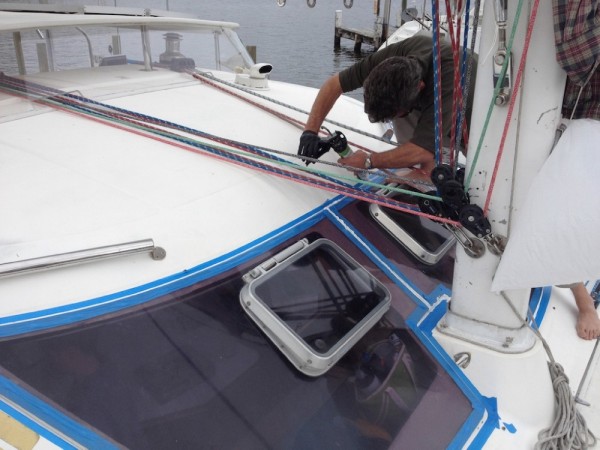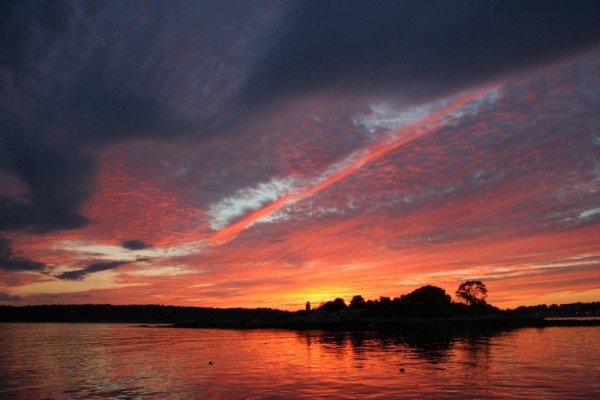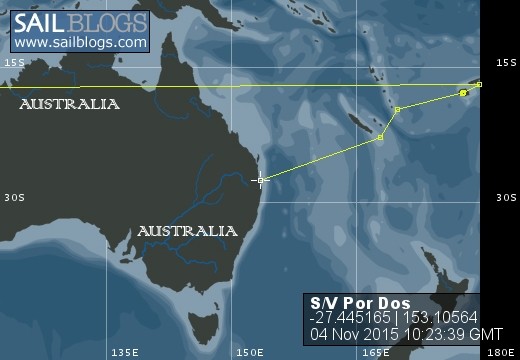
Por Dos
Family cruising in a Catamaran
16 December 2017 | Brisbane
04 November 2015 | Brisbane, Australia
30 October 2015 | Isle de Pines, Noumea, New Caledonia
08 October 2015 | Tanna, Vanuatu
01 October 2015 | Viti Levu, Mololo, Fiji
21 September 2015 | Namena, Musket Cove Malolo, Vuda Point Viti Levu, Fiji
12 September 2015 | Vanua Levu and Taveuni, Fiji
02 September 2015 | Tonga
13 August 2015 | Suwarrow, Cook Islands
25 July 2015 | Tahaa, Bora Bora and Maupiti French Polynesia
17 June 2015 | Tahiti & Moorea, French Polynesia
16 June 2015 | Fakarava, Tuamotu Islands, French Polynesia
06 June 2015 | Tahanea, Tuamotu Islands, French Polynesia
01 June 2015 | Raiatea, Tuamotu Islands, French Polynesia
28 May 2015 | Taiohae Bay, Nuku Hiva, Marquesas Islands, French Polynesia
12 May 2015 | Taiohae Bay, Nuku Hiva, Marquesas Islands, French Polynesia
26 April 2015 | Academy Bay, Puerto Ayora, Santa Cruz, Islas Galapagos, Ecuador
13 April 2015 | Panama to Galapagos
07 April 2015 | Balboa, Panama
31 March 2015 | Colon, Panama
Baltimore Museums
25 September 2012 | Baltimore MD
Roan Morwood-Portoles
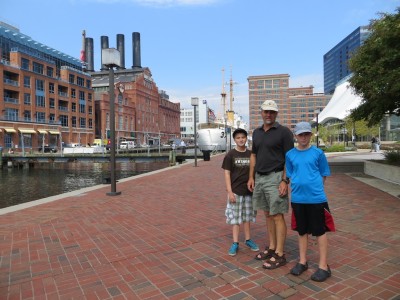
We arrived in Baltimore at 12:30 on the 24th of September. We anchored in a small anchorage in-between two marinas. Before we even got to Baltimore we had decided to go to Fort McHenry, the National Aquarium, and the Baltimore Museum of Maritime History, which wasn’t really a museum but more of a collection of boats.
The next day, after we had finished school at about 10:30, we went to the Maritime museum and the National Aquarium. We thought about catching the water taxi, but there were none at the dock when we got there, so we just did the 30 minute walk. We arrived in downtown Baltimore and bought tickets for the maritime museum for two boats and went to explore the Baltimore Light Ship first.
The lightships are all red and have their station (Chesapeake, Nantucket, etc.) painted on the side in big white letters, in this case the lightship that we were visiting was the Baltimore. Their job is to stay out at the entrance of harbors and particularly in rough sea areas. They are about 100 ft. long and have large bows rounded like a canoe-stern, they have two tall masts on top of which they have a large light just like a lighthouse.
After an extensive visit to the light ship we decided to go to the aquarium next instead of another ship because we thought that it closed earlier than the maritime museum. But first we went to a place for lunch called Potbelly Sandwiches, and if you ever are visiting downtown Baltimore for lunch near the Aquarium I recommend that you go there. The sandwiches are delicious and served warm with your choice of toppings. Back to the main subject, after lunch we headed into the Aquarium.
The aquarium was super cool with many different exhibits. First we went to the Australian “wing”. There was an aquarium staff member holding a lizard in the first corridor and he explained to us all sorts of things about it, for example it was related to the Komodo Dragon. It was really interesting to hear. I was really surprised that they had more than marine life animals like birds and lizards. The Australian “Wing” had many lizards and snakes and some Australian birds too. We came to the fresh-water crocodile exhibit just in time to see a staff member feed the turtles that were in it with the crocodiles. He fed them lettuce pushing the crocodiles aside with a metal screen, and looking warily around to check where all the crocodiles where. In the last exhibit of the Australian section, there was a really big fish that was about 3ft long that could breathe air called the Lung Fish.
After that we moved on to the dolphin pool and saw a research project in progress. The dolphins in the deep pool had to touch symbols on an underwater panel with their nose. Each symbol gave them different toys. One of them pushed one of the buttons and they gave him a ball to play, another time he got a Frisbee or a rope with a fender at the end to play with. We didn’t stay for the whole project though because there were a lot of repeats so instead we went to check on the Jellyfish Exhibit.
The Jellyfish Exhibit was a new addition to the aquarium, and it spoke of how polluting the water made the other fish move but the jellyfish thrived on the large amount of nutrients in the water. There were population explosions where there were no predators in the area to eat them, so they grew and grew and grew. It also had some pretty cool facts such as the Lions Mane jellies stingers are as long as three buses. There were lots of other different jellyfish in tanks around the room with fact panels that had interesting information about them.
We headed out of the Jelly exhibit and decided to go back to the dolphins exhibit to watch one of the shows. The show was fairly interesting and there were a lot of “commands” and signals. The dolphins knew that meant what trick to do like to jump really high in the air or do a backflip wave your flippers and tricks like that.
We were going to head to the ocean and rainforest exhibit when we realized that the museum closed later than the maritime museum, so we went to see the maritime museum ship, the U.S. sloop of war Constellation, the last all sailing warship built by the United States around the 1850’s. It was long and had one deck of guns with some mounted on the bow and the stern. We were allowed to explore all of the 4 decks. The main deck was where all of the sailing happened with a large double steering wheel, and the bathroom was just a hole on the bowsprit.
The first deck below the main deck was the gun deck with all of the cannons sticking out of the side with the huge manual anchor winch (the Capstan).
Below that was the sleeping deck where all of the crew officers and captain slept. The crew just slept in a large open area with huge amount of hammocks hanging from the ceiling of the sleeping deck, the crew had to eat on the floor in the open space below all the hammocks. To the stern there were the midshipman quarters, which were much less crowded although they still had hammocks. Next the Lieutenants each had their own room with a small bed and room for some belongings. Even farther astern was the captain’s quarters who had his own bathroom and a nice bed, his own office room about as large as a midshipman’s room, and way up in the bow was the doctor’s work room the ship’s mini hospital with hammocks for the patients, except they had hard bottoms and were just loose pieces of cloth swinging with the ship.
Below that deck there was the storage deck and as you came down the ladder the head room drastically changed from about 8-10 feet to 4ft of headroom but then it opened up to a HUGE storage deck, and I thought wow this ship must have like 30 foot draft! It had a large amount of ballast (all iron). We moved forward up to the bow where there was the brig (jail on old ships) for punishing sailors. After finishing examining the last of the ship we headed back up the decks and to the Aquarium.
We went back into the aquarium to see the Atlantic Reef and Rainforest Exhibit. The rainforest exhibit was a large jungle grown inside the building. It was steaming in the exhibit since the pipes regularly misted water into the exhibit and presumably there was a heating system blowing hot air into the room. There were birds all over the place and some piranha fish. Next we went to the Ocean Reef exhibit looking at all the different fishes found in the different places of ocean reefs from the Atlantic to the Pacific Great Barrier Reef. It was really cool.
An escalator took us by an exhibit in the making, and judging by the huge whale skeleton suspended to the ceiling by steel wire I guessed that it was a whale exhibit. But then the escalator took us to the fish “types” exhibit. It had the same layout as the previous exhibit but instead of the reefs it had types of fish protection and hunting for example one of them was ambushing fish that would lie in wait for fish to come by suddenly taken unawares by the 9-foot long moray eel that appeared in front of them. There was also a electric protection tank where they had an electric eel which had the ability to discharge 800 volts of electricity from hundreds of electrical organs each producing about 2-3 volts which wouldn’t be to much alone but together they could stun a fully grown man.
After the “types” of fish Exhibit we moved on to the walk-through fish and shark tank. First we walked above a 15-foot deep fish tank with all sorts of reef fish swimming around in the circular tank. Then the walkway spiraled down deeper and deeper until after 2 full loops of walking around the tank the fish tank stopped and the shark tank began. It had the same design as the fish tank except it was only 10 foot deep and it was filled with sawfish and sharks and after only one rotation it ended and we had seen the whole Aquarium. We walked home after a long day and got to the boat at around 8:00.
The next day, after we had finished school at about 10:30, we went to the Maritime museum and the National Aquarium. We thought about catching the water taxi, but there were none at the dock when we got there, so we just did the 30 minute walk. We arrived in downtown Baltimore and bought tickets for the maritime museum for two boats and went to explore the Baltimore Light Ship first.
The lightships are all red and have their station (Chesapeake, Nantucket, etc.) painted on the side in big white letters, in this case the lightship that we were visiting was the Baltimore. Their job is to stay out at the entrance of harbors and particularly in rough sea areas. They are about 100 ft. long and have large bows rounded like a canoe-stern, they have two tall masts on top of which they have a large light just like a lighthouse.
After an extensive visit to the light ship we decided to go to the aquarium next instead of another ship because we thought that it closed earlier than the maritime museum. But first we went to a place for lunch called Potbelly Sandwiches, and if you ever are visiting downtown Baltimore for lunch near the Aquarium I recommend that you go there. The sandwiches are delicious and served warm with your choice of toppings. Back to the main subject, after lunch we headed into the Aquarium.
The aquarium was super cool with many different exhibits. First we went to the Australian “wing”. There was an aquarium staff member holding a lizard in the first corridor and he explained to us all sorts of things about it, for example it was related to the Komodo Dragon. It was really interesting to hear. I was really surprised that they had more than marine life animals like birds and lizards. The Australian “Wing” had many lizards and snakes and some Australian birds too. We came to the fresh-water crocodile exhibit just in time to see a staff member feed the turtles that were in it with the crocodiles. He fed them lettuce pushing the crocodiles aside with a metal screen, and looking warily around to check where all the crocodiles where. In the last exhibit of the Australian section, there was a really big fish that was about 3ft long that could breathe air called the Lung Fish.
After that we moved on to the dolphin pool and saw a research project in progress. The dolphins in the deep pool had to touch symbols on an underwater panel with their nose. Each symbol gave them different toys. One of them pushed one of the buttons and they gave him a ball to play, another time he got a Frisbee or a rope with a fender at the end to play with. We didn’t stay for the whole project though because there were a lot of repeats so instead we went to check on the Jellyfish Exhibit.
The Jellyfish Exhibit was a new addition to the aquarium, and it spoke of how polluting the water made the other fish move but the jellyfish thrived on the large amount of nutrients in the water. There were population explosions where there were no predators in the area to eat them, so they grew and grew and grew. It also had some pretty cool facts such as the Lions Mane jellies stingers are as long as three buses. There were lots of other different jellyfish in tanks around the room with fact panels that had interesting information about them.
We headed out of the Jelly exhibit and decided to go back to the dolphins exhibit to watch one of the shows. The show was fairly interesting and there were a lot of “commands” and signals. The dolphins knew that meant what trick to do like to jump really high in the air or do a backflip wave your flippers and tricks like that.
We were going to head to the ocean and rainforest exhibit when we realized that the museum closed later than the maritime museum, so we went to see the maritime museum ship, the U.S. sloop of war Constellation, the last all sailing warship built by the United States around the 1850’s. It was long and had one deck of guns with some mounted on the bow and the stern. We were allowed to explore all of the 4 decks. The main deck was where all of the sailing happened with a large double steering wheel, and the bathroom was just a hole on the bowsprit.
The first deck below the main deck was the gun deck with all of the cannons sticking out of the side with the huge manual anchor winch (the Capstan).
Below that was the sleeping deck where all of the crew officers and captain slept. The crew just slept in a large open area with huge amount of hammocks hanging from the ceiling of the sleeping deck, the crew had to eat on the floor in the open space below all the hammocks. To the stern there were the midshipman quarters, which were much less crowded although they still had hammocks. Next the Lieutenants each had their own room with a small bed and room for some belongings. Even farther astern was the captain’s quarters who had his own bathroom and a nice bed, his own office room about as large as a midshipman’s room, and way up in the bow was the doctor’s work room the ship’s mini hospital with hammocks for the patients, except they had hard bottoms and were just loose pieces of cloth swinging with the ship.
Below that deck there was the storage deck and as you came down the ladder the head room drastically changed from about 8-10 feet to 4ft of headroom but then it opened up to a HUGE storage deck, and I thought wow this ship must have like 30 foot draft! It had a large amount of ballast (all iron). We moved forward up to the bow where there was the brig (jail on old ships) for punishing sailors. After finishing examining the last of the ship we headed back up the decks and to the Aquarium.
We went back into the aquarium to see the Atlantic Reef and Rainforest Exhibit. The rainforest exhibit was a large jungle grown inside the building. It was steaming in the exhibit since the pipes regularly misted water into the exhibit and presumably there was a heating system blowing hot air into the room. There were birds all over the place and some piranha fish. Next we went to the Ocean Reef exhibit looking at all the different fishes found in the different places of ocean reefs from the Atlantic to the Pacific Great Barrier Reef. It was really cool.
An escalator took us by an exhibit in the making, and judging by the huge whale skeleton suspended to the ceiling by steel wire I guessed that it was a whale exhibit. But then the escalator took us to the fish “types” exhibit. It had the same layout as the previous exhibit but instead of the reefs it had types of fish protection and hunting for example one of them was ambushing fish that would lie in wait for fish to come by suddenly taken unawares by the 9-foot long moray eel that appeared in front of them. There was also a electric protection tank where they had an electric eel which had the ability to discharge 800 volts of electricity from hundreds of electrical organs each producing about 2-3 volts which wouldn’t be to much alone but together they could stun a fully grown man.
After the “types” of fish Exhibit we moved on to the walk-through fish and shark tank. First we walked above a 15-foot deep fish tank with all sorts of reef fish swimming around in the circular tank. Then the walkway spiraled down deeper and deeper until after 2 full loops of walking around the tank the fish tank stopped and the shark tank began. It had the same design as the fish tank except it was only 10 foot deep and it was filled with sawfish and sharks and after only one rotation it ended and we had seen the whole Aquarium. We walked home after a long day and got to the boat at around 8:00.
Comments
| Vessel Name: | S/V Por Dos |
| Vessel Make/Model: | Catana 48 |
| Hailing Port: | Salem, MA |
| Crew: | Mark, Marta, Alec & Roan |
Us
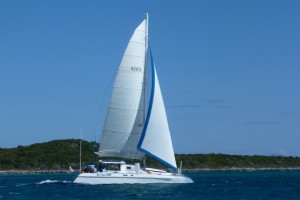
Who: Mark, Marta, Alec & Roan
Port: Salem, MA
